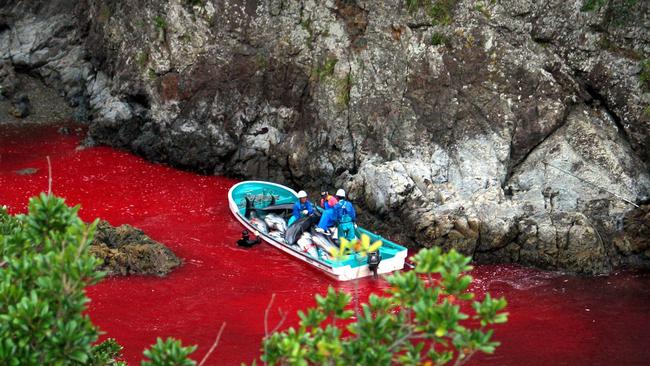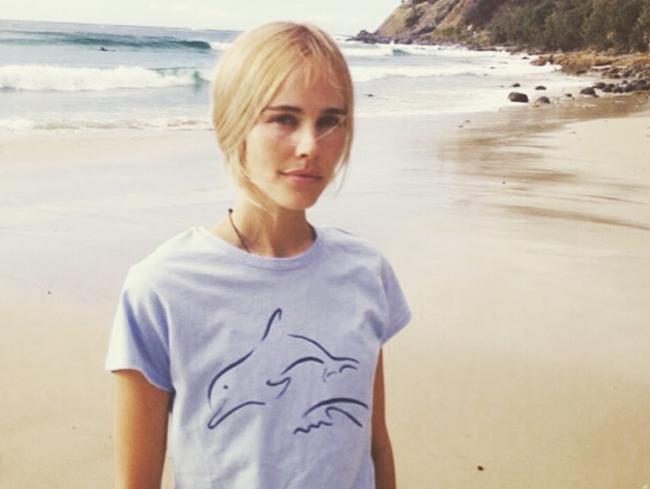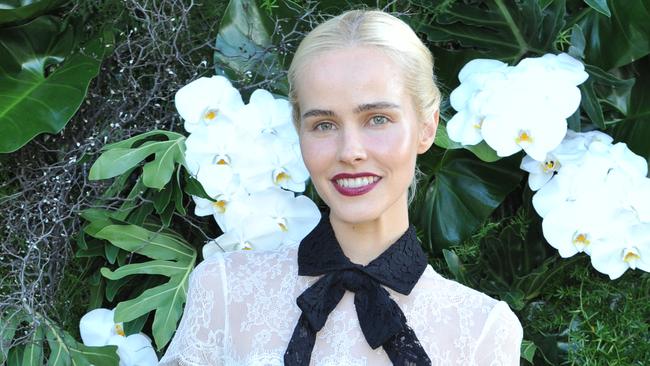Isabel Lucas, actor and activist, protests dolphin slaughter at ‘The Cove’, Taiji, Japan
AUSSIE actor-activist Isabel Lucas once paddled into the heart of a Japanese dolphin hunt to stop the brutal practice. She writes why she’s still fighting.
THE dolphin hunts started today, but I’m not disheartened because I believe in change.
“Why are you here? Go home!” yelled the frenzied hunters as we paddled out through the threats.
It was 2007, when the group of us including my friend Dave Rastovich, Founder of Surfers for Cetaceans, and other friends and dolphin advocates together formed a circle in honour for the many dolphin and whale lives that had been forfeited in this cove.
On our boards we closed our eyes and joined hands and said a silent surfers’ tribute.
Looking into the cove as far as we could see surrounding us the water was blood-red.
I have never witnessed such injustice and disconnection from the sentient nature of life.
This was now eight years ago at the now-infamous dolphin killing cove in Taiji, Japan.
Since then the hunts have been exposed in an Oscar-winning documentary (“The Cove”) and condemned by everyone from Yoko Ono to US Ambassador to Japan, Caroline Kennedy.
You might imagine that, after so much global criticism, these brutal hunts would have stopped. Unfortunately, this is not the case. The dolphin hunts still happen every year from September through to March.

Sadly, the first pod of dolphins for the year was caught today.
This morning a group of dolphins were captured in Taiji, marking the start of the town’s infamous hunting season.
Soon, dolphin trainers from around the world will arrive to hand-pick the “prettiest” dolphins for aquariums.
The rest of the pod will be brutally stabbed with metal rods before slowly drowning to death in their own blood.

Why is this senseless cruelty still happening in 2015? It is not because dolphin hunting is a “cultural tradition”, as the hunters claim.
In fact, according to the town’s own official history, the hunts only started in Taiji in 1969.
When the television series “Flipper” became popular, Taiji fishermen realised they could make big money selling live dolphins to aquariums.

Now, a trained dolphin captured from the wild can fetch upwards of $100,000.
It is this multi-million dollar aquarium trade that motivates the hunts.
The “good-looking” dolphins are sold into miserable lives at aquariums, where 50 per cent of them die in the first three months.
The rest are brutally slaughtered and sold cheaply as dog food.
While it’s incredibly sad to see the hunts continue in Japan, I’m not disheartened. And that’s because powerful progress is finally being made. We are waking up ...
Earlier this year a local organisation with just three fulltime staff caused a huge disruption in Taiji.

Australia for Dolphins managed to cut demand for Taiji dolphins in half when they brought legal action against aquariums purchasing from the hunts.
Because of this action dolphin hunters can no longer sell to Japanese aquariums.
Hopefully, this win will spare thousands of dolphins from the horror of capture this year.
According to Australia for Dolphins CEO Sarah Lucas, “The capture and slaughter of dolphins in Taiji is one of the worst acts of animal cruelty imaginable.”

She says the brutal killing method would not be accepted “in any regulated slaughterhouse in the world — including in Japan”.
But in the last few weeks, Australia for Dolphins has collected more than 120,000 signatures from concerned individuals demanding the Governor of Wakayama cancel the dolphin hunting permit and end the bloodbath in Taiji.
What this tells me is that we can make progress, if we keep trying.
It’s a thought that fills me with reassurance and strength.
Especially today, as another pod of innocent dolphins awaits their death in the killing cove.
Originally published as Isabel Lucas, actor and activist, protests dolphin slaughter at ‘The Cove’, Taiji, Japan





